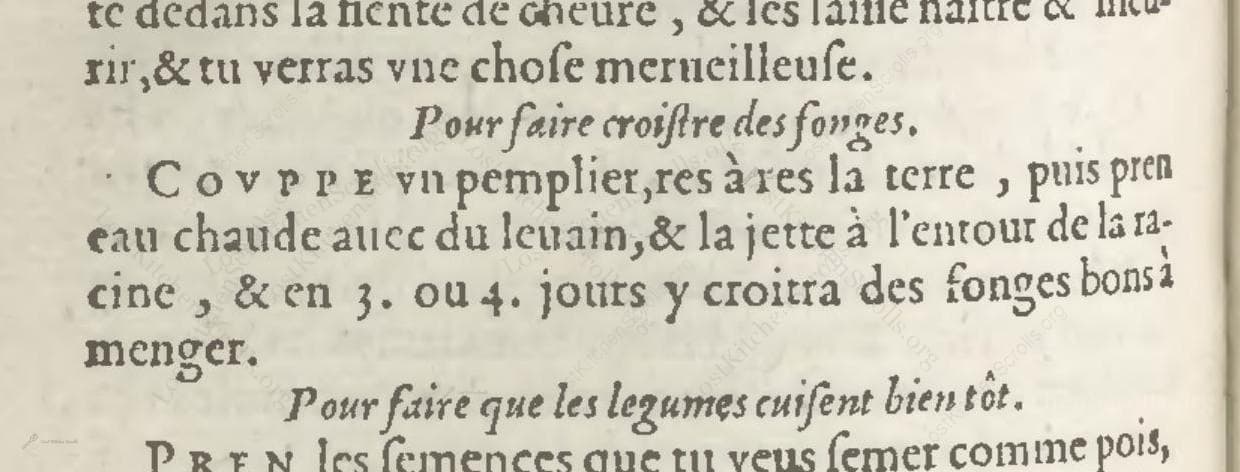Pour Faire Croistre Des Songes
"To Make Yams Grow"
From the treasured pages of Les secrets du seigneur Alexis Piemontois
Written by Girolamo Ruscelli

Pour Faire Croistre Des Songes
"COVPPE vn pemplier, res à res la terre, puis pren eau chaude auec du leuain, & la jette à l'entour de la racine, & en 3. ou 4. jours y croitra des songes bons à menger."
English Translation
"Cut a poplar tree, close to the ground, then take hot water with some leaven, and pour it around the root, and in 3 or 4 days yams will grow there, good to eat."
Note on the Original Text
Recipes in the Renaissance were often written in the imperative and elliptic style, instructing the reader to act directly: 'Cover the roots, pour...' rather than detailing precise steps. Time and temperature indications were rough ('in 3 or 4 days,' 'hot water'), reflecting the variable nature of home kitchens and gardens. Orthography is archaic—'pemplier' is 'peuplier' (poplar), 'leuain' is 'levain' (leaven/yeast), and 'songes' plays on the period ambiguity between mushrooms and dreams. Latinisms and orthographic inconsistencies were typical, and practical experience was expected of the reader.

Title
Les secrets du seigneur Alexis Piemontois (1564)
You can also click the book image above to peruse the original tome
Writer
Girolamo Ruscelli
Era
1564
Publisher
Christophe Plantin
Background
Unlock the culinary alchemy of Renaissance Europe with "Les secrets du seigneur Alexis Piemontois"—a tantalizing trove of recipes, formulas, and household secrets distilled by the esteemed Girolamo Ruscelli and his illustrious contemporaries. Divided into six convenient books, this delightful compendium reveals the flavors, remedies, and ingenious practices of a bygone gourmet age.
Kindly made available by
Library of Congress
This recipe comes from the 1564 edition of 'Les secrets du seigneur Alexis Piemontois,' a celebrated compendium of practical and magical household knowledge, attributed to Girolamo Ruscelli and published by Christophe Plantin in Antwerp. The work was a bestseller of its time, blending Renaissance experimentalism with rumors, alchemical notions, and practical wisdom. Recipes like this, straddling the boundary between the natural and the fantastical, reflect how early modern people sought to manipulate their world by both scientific and magical means. The recipe is categorized among medical and household secrets—concoctions and treatments that promise to cultivate not just food but wonders. 'Songes' in the period French refers ambiguously to either mushrooms or, literally, 'dreams,' but in context likely points to mushrooms believed to spring up magically when stimulated by simple means.

In the 16th century, this recipe would have required a sturdy spade or digging tool for exposing the roots of the poplar tree. A large clay or wooden bucket would have been used to heat and mix water on the hearth, while a wooden spoon or stick helped dissolve the leaven. The yeast itself could be homemade sourdough or brewer’s yeast, commonly available in market towns. No fine measuring tools would have been used; quantities were gauged by hand, eye, and feel. The recipe is as much an experiment as it is a culinary instruction.
Prep Time
30 mins
Cook Time
0 mins
Servings
1
We've done our best to adapt this historical recipe for modern kitchens, but some details may still need refinement. We warmly welcome feedback from fellow cooks and culinary historians — your insights support the entire community!
Ingredients
- 1 black poplar tree (Populus nigra), or suitable poplar substitute
- 1 quart warm water (about 113°F)
- 1.75 ounces fresh baker's yeast (substitute: sourdough starter, if fresh yeast unavailable)
Instructions
- Begin by uncovering the roots of a black poplar tree (Populus nigra), scraping away the earth around the base until the roots are exposed.
- Next, prepare about 1 quart of warm water (around 113°F) and dissolve 1.75 ounces of fresh baker's yeast into the water, stirring until the yeast is melted thoroughly.
- Pour this warm, yeasty mixture liberally all around the exposed roots of the tree.
- Leave the treated area for 3 to 4 days.
- According to the original recipe, edible mushrooms (likely referring to dream-inducing or desirable kinds; possibly referring to poplar field mushrooms or common field mushrooms) should appear, suitable for consumption.
- While the immediate use of yeast as a growth stimulant is somewhat folkloric, this captures the historical process as closely as possible.
Estimated Calories
20 per serving
Cooking Estimates
Preparing the recipe takes about 30 minutes, including uncovering the roots and mixing the yeast solution. After pouring the mixture, you must wait 3 to 4 days for possible mushrooms to appear. The actual 'cooking' is minimal, since you are using nature's process. Calorie content is based on consuming one average-sized mushroom that may grow.
As noted above, we have made our best effort to translate and adapt this historical recipe for modern kitchens, taking into account ingredients nowadays, cooking techniques, measurements, and so on. However, historical recipes often contain assumptions that require interpretation.
We'd love for anyone to help improve these adaptations. Community contributions are highly welcome. If you have suggestions, corrections, or cooking tips based on your experience with this recipe, please share them below.
Join the Discussion
Rate This Recipe
Dietary Preference
Main Ingredients
Culinary Technique
Occasions

Den Bockfisch In Einer Fleisch Suppen Zu Kochen
This recipe hails from a German manuscript cookbook compiled in 1696, a time whe...

Die Grieß Nudlen Zumachen
This recipe comes from a rather mysterious manuscript cookbook, penned anonymous...

Ein Boudain
This recipe comes from an anonymous German-language manuscript cookbook from 169...

Ein Gesaltzen Citroni
This recipe, dating from 1696, comes from an extensive anonymous German cookbook...
Browse our complete collection of time-honored recipes



